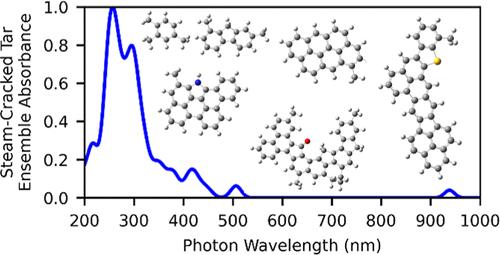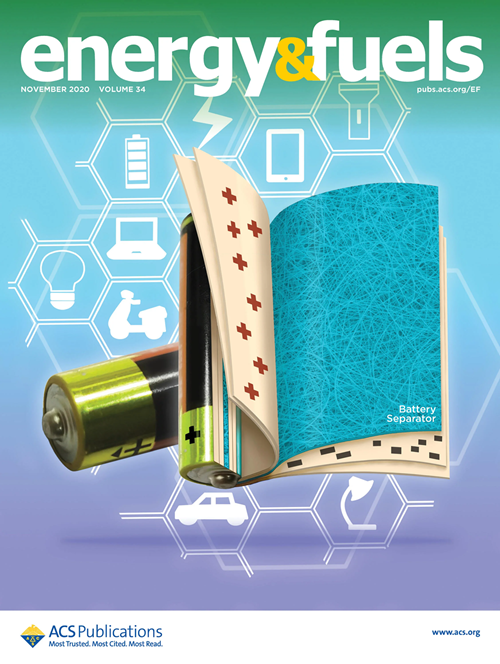从单分子成像获得的结构预测集合属性分布的计算工作流程:蒸汽裂解焦油、煤衍生沥青烯和石油沥青的应用
IF 5.3
3区 工程技术
Q2 ENERGY & FUELS
引用次数: 0
摘要
石油原油、煤焦油、沥青、石油沥青和相关材料是异常复杂的化学混合物。在过去十年中,单分子成像技术已被用于测量许多此类有机混合物的化学结构。这些结构代表了丰富的数据集,可用于完善有关结构/性质关系的假设。为此,我们提出了一个工作流程,利用计算化学来预测化学结构集合的集合属性分布。我们将这一工作流程应用于三个化学结构数据库,这三个数据库分别来自蒸汽裂解焦油、煤衍生沥青烯和 M-50 石油沥青的单分子成像。我们使用我们的工作流程来预测每个集合的多种特性:化学多样性、辛醇/水分配、利平斯基规则定义的 "药物相似性"、碳 X 射线光电子能谱 (XPS) 光谱、紫外/可见光谱和近红外吸光度。我们的研究结果证实,成像结构具有化学多样性,只有 35% 的结构存在于 PubChem 数据库中。辛醇/水分配的预测集合分布相当广泛,突出了符合利宾斯基规则的 "类药物 "分子的存在。预测的碳 XPS 光谱为今后结合同一样品的单分子成像和集合 XPS 测量进行实验研究提供了原理证明。预测的紫外/可见吸收光谱与之前的工作一致。最重要的是,预测的近红外吸收率为原油、沥青质和相关材料中出现的近红外吸收尾迹提供了一种新的结构假设。我们假设,近红外吸收来自于多环芳香族二环化合物的cata-condensed,其中三个在单分子图像中可见。我们认为,计算化学工作流程可以作为一种有用的工具,用于完善复杂混合物的集合结构/性质假设。本文章由计算机程序翻译,如有差异,请以英文原文为准。

Computational Workflows to Predict Ensemble Property Distributions from Structures Obtained by Single-Molecule Imaging: Application to Steam-Cracked Tar, Coal-Derived Asphaltene, and Petroleum Pitch
Petroleum crude oil, coal tars, bitumen, petroleum pitch, and related materials are extraordinarily complex chemical mixtures. Over the past decade, single-molecule imaging has been used to measure chemical structures in many of these organic mixtures. These structures represent a rich data set for refining hypotheses about structure/property relationships. To facilitate this, we present a workflow which uses computational chemistry to predict ensemble property distributions from ensembles of chemical structures. We apply this workflow to three databases of chemical structures taken from single-molecule imaging of a steam-cracked tar, a coal-derived asphaltene, and M-50 petroleum pitch. We use our workflow to predict multiple properties of each ensemble: chemical diversity, octanol/water partitioning, “druglikeness” as defined by Lipinski’s rules, carbon X-ray photoelectron spectroscopy (XPS) spectra, UV/vis spectra, and near-infrared absorbance. Our results confirm that the imaged structures are chemically diverse, with only 35% of the structures present in the PubChem database. The predicted ensemble distribution of octanol/water partitioning is quite broad, and highlights the presence of “druglike” molecules satisfying Lipinski’s rules. The predicted carbon XPS spectra provide a proof-of-principle for future experimental studies combining single-molecule imaging and ensemble XPS measurements of the same sample. The predicted UV/vis absorption spectra are consistent with previous work. Most importantly, the predicted near-infrared absorbance provides a novel structural hypothesis for the near-IR absorption tail seen in crude oil, asphaltenes, and related materials. We hypothesize that near-IR absorption comes from cata-condensed polycyclic aromatic diradicaloids, three of which are visible in the single-molecule images. We suggest that computational chemistry workflows can be a useful tool for refining ensemble structure/property hypotheses in complex mixtures.
求助全文
通过发布文献求助,成功后即可免费获取论文全文。
去求助
来源期刊

Energy & Fuels
工程技术-工程:化工
CiteScore
9.20
自引率
13.20%
发文量
1101
审稿时长
2.1 months
期刊介绍:
Energy & Fuels publishes reports of research in the technical area defined by the intersection of the disciplines of chemistry and chemical engineering and the application domain of non-nuclear energy and fuels. This includes research directed at the formation of, exploration for, and production of fossil fuels and biomass; the properties and structure or molecular composition of both raw fuels and refined products; the chemistry involved in the processing and utilization of fuels; fuel cells and their applications; and the analytical and instrumental techniques used in investigations of the foregoing areas.
 求助内容:
求助内容: 应助结果提醒方式:
应助结果提醒方式:


